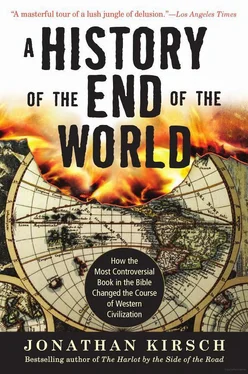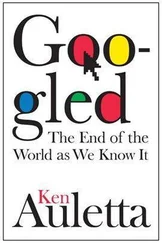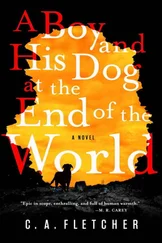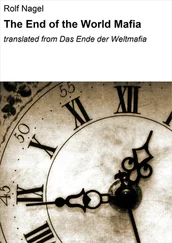“Now, this is the eighth year since we heard these words from his lips,” writes Sulpicius in a work that first appeared at the beginning of the fifth century. “You may guess, then, how soon those things which we fear in the future are about to happen.” 91
Signs of the end-times were seen everywhere by those who were looking for them in the fifth century. The barbarians at the gates of Rome, many of whom were baptized Christians, were seen as the armies of Satan whose arrival signaled the Second Coming: “Behold, from Adam all the years have passed,” declared one Christian sermonizer when Alaric and the Visigoths sacked the imperial capital in 410, “and now comes the day of judgment!” 92Earthquakes in Palestine and a solar eclipse that was recorded on July 19, 418, were seen as fulfillments of the prophecies of Revelation: “And I beheld when he had opened the sixth seal, and, lo, there was a great earthquake, and the sun became black as sackcloth, and the moon became as blood.” 93
Indeed, there were even more extravagant examples of the “ridiculous fancies” that Augustine so coolly disdained. Caught up in the apocalyptic panic—or, more likely, preying on those who were—one young man in Spain advertised himself as the resurrected John the Baptist and another man in the eastern reaches of the Roman Empire posed as Elijah, thus invoking the passage in Revelation that predicts the coming of the two “witnesses” who would be the precursors of Christ. And a Christian chronicler of the same era argued that the numerical value of “Genseric,” the name of the Vandal king who had placed himself on the throne of Carthage in North Africa, was the dreaded and demonic 666.
The Roman empire may have been in its decline and fall during the tumultuous years of the fifth century—but the world manifestly did not end, and the prophecies of Revelation remained unfulfilled. Still, the readers of Revelation continued to look for signs and wonders in the world around them. After the armies of Islam charged out of the Arabian peninsula in the seventh century, for example, the prophet Muhammad emerged as a compelling candidate for the Antichrist. One Spanish visionary, for example, calculated that Muhammad died in the year 666 on the Christian calendar—a fact that he confidently cited as proof that the founding prophet of Islam was the “beast” of Revelation whose death augured the imminent end of the world.
Once it began, of course, the restless and relentless search for a fleshand-blood Antichrist never ended, and precisely because the world itself never ended. Nero was an attractive candidate for the title of Antichrist among the readers and hearers of Revelation who recalled the first persecution of Christians in Rome, but Muhammad was a more credible choice for someone living in the early Middle Ages. During the Crusades, Saladin was seen as the Antichrist, and when the Turks conquered Constantinople in 1453, the Sultan of the Ottoman empire was the Antichrist of the hour. By the sixteenth century, Martin Luther and the pope of the Roman Catholic Church regarded each other as the Antichrist. At any given point between late antiquity and our own times, the usual suspects in the search for the Antichrist have reflected the anxieties of the age.
“Pin-the-tail-on-the-Antichrist” has always been a popular pastime among some readers of Revelation. But perhaps even more energy and enterprise have been invested in the effort to calculate exactly when the world will end by studying the mystical numbers that are embedded in the text of Revelation. Jesus specifically forbids any such speculation—and Augustine admonishes all good Christians who are inclined to count the years until doomsday to “relax your fingers, and give them a little rest”—but the plain words of the Gospels and the church fathers have never deterred the mystical number-crunchers. 94
Like so much else in the apocalyptic tradition, the numbers game begins in the book of Daniel, where the prophet is granted a vision of the final ordeal of Israel: “It shall be for a time, times, and a half,” says one of his celestial mentors, “and when he shall have accomplished to scatter the power of the holy people, all these things shall be finished.” 95By extrapolating from other and rather less obscure passages of Daniel—the prophet, as we have seen, refers to a period of 1,290 days or 1,335 days as the countdown clock to final salvation, a period roughly equal to three and a half years—some early readers of the book of Daniel decided that a “time” is a year, and “times” is two years. Thus, “a time, times, and a half” is understood to mean three and a half years.
Precisely the same period of time is invoked almost obsessively the book of Revelation. The woman clothed with the sun, for example, flees to the desert to escape the red dragon—and, according to John, she will stay there “a time, and times, and half a time.” Elsewhere in Revelation, John specifies that her sojourn will last 1,260 days. He predicts that the Gentiles will trample the holy city of Jerusalem for forty-two months, and the two witnesses will prophesy for 1,260 days. And John later predicts that the “beast from the sea” will reign over earth for forty-two months. 96All of these periods are equal to three and a half years if we calculate on the basis of a thirty-day month. And, not coincidentally, three and one half is exactly half of John’s favorite number, the divine number seven.
According to a certain conventional wisdom that came to be embraced by apocalyptic date-setters, John means to reveal that the end of the world will come exactly three and a half years after the appearance of the Antichrist. A North African bishop called Evodius of Uzala, for example, assured his congregation in 412 that Satan himself will reign over the world as the Antichrist for exactly three and a half years before Jesus Christ returns to earth in triumph, all as predicted in the book of Revelation. The same three-and-a-half-year period was invoked throughout late antiquity and the Middle Ages as the countdown to the end-times.
Once convinced that the arrival of the Antichrist was the triggering event for the countdown to the end of the world, Christian doomsayers were all the more alert and active in searching for likely prospects among the flesh-and-blood kings and conquerors in their own world. The book of Revelation offers both bad news and good news, as we have seen, and here is yet another example: the Antichrist will bring oppression and persecution, to be sure, but he is also the surest sign that Jesus Christ is on his way. And, after all, three and a half years is not such a long time to wait for the rewards that are promised in Revelation—the second coming of Jesus Christ, the millennial kingdom, the final defeat of Satan, the Day of Judgment and, for a happy few, eternal life in the new heaven and the new earth. Apocalyptic true believers have been on the lookout for the Anti-christ ever since.
But on the question of timing, too, the apocalyptic imagination has never been satisfied with simple notions, and far more elaborate theories were proposed in the early Middle Ages for calculating the end-times. The most enduring and pervasive theory is based on an ancient tradition that the history of the world from beginning to end can be divided into seven periods, each one a thousand years in duration. The seed of the idea can be found in a stray line of Jewish scripture—“For a thousand years in your sight are but as yesterday,” says the Psalmist to God in the Hebrew Bible—but it sprouted and flowered in some remarkable ways in the hothouse of the apocalyptic tradition. 97
The same simile, for example, is rephrased in the Christian scriptures in a way that suggests a more literal meaning: “One day is with the Lord as a thousand years,” writes the author of the epistles of Peter, “and a thousand years as one day.” 98And the readers of Revelation elaborated on these spare lines of scripture by imagining that the seven days of creation in Genesis are meant to predict the so-called World Week—that is, seven ages of history, each age a thousand years in duration. The seventh and final “day” in the cosmic week of ages—the so-called Sabbath Age—will be the thousand-year reign of Christ on earth as predicted in Revelation.
Читать дальше










